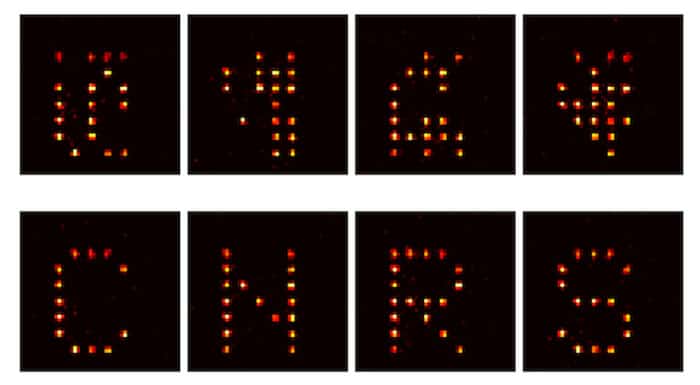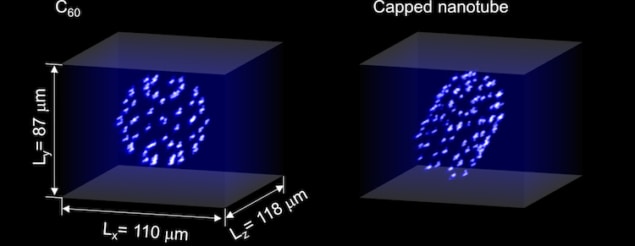Engineered atomic arrays for quantum computers
05 Sep 2018 Belle Dumé
Researchers at the Institut d’Optique Graduate School at the CNRS and Université Paris-Saclay in France have used a laser-based technique to rearrange cold atoms one-by-one into fully ordered 3D patterns. The arrays, which contain as many as 72 neutral atoms held in an optical trap, could be used to simulate quantum complex many-body systems in physics.
While classical computers store and process information as “bits” that can have one of two states – “0” or “1” – a quantum computer exploits the ability of quantum particles to be in “superposition” of two or more states at the same time. Such a device could, in principle, outperform a classical computer for solving some advanced computational problems, such as factoring large numbers or simulating the interactions between many fundamental particles.
In recent years, researchers have been trying to adapt a number of quantum methods and technologies, such as superconducting qubits and trapped ions, to build real-world quantum computers and much progress is being made in this field. A team led by Antoine Browaeys
of the Laboratoire Charles Fabry is now reporting on a new technology based on trapped neutral atoms.
of the Laboratoire Charles Fabry is now reporting on a new technology based on trapped neutral atoms.
Neutral atoms are proving promising for quantum computing because qubits made from them are extremely well isolated from surrounding environmental noise so their encoded state remains intact. They can also be finely controlled using optical traps (or tweezers) and scaled up to large numbers of qubits. Optical tweezers work by trapping tiny objects near the focus of a laser beam and the technique allows these objects to be picked up and moved to another place using just light forces.
Controlled interactions required
Quantum-computing operations require controlled interactions between atoms, so, computers based on neutral atom qubits will first need to be precisely arranged in a specific pattern. Such patterns have proved difficult to make until now, however – and especially using neutral atom qubits. Although researchers have succeeded in arranging these atoms in 1D and 2D, they will need to be able to stack them in 3D as the number of qubits reaches the hundred mark, and to make structures that are just not possible in 2D.
In their experiments, Browaeys and colleagues made use of a spatial light modulator to generate microtraps (arranged in, for example, bilayer graphene structures or pyrochlore lattices) separated by a few microns. “We initially randomly load and half-fill these traps with cold rubidium atoms,” explains study lead author Daniel Barredo. “We then use a combination of acousto-optical deflectors and electrically tuneable lenses to create moving optical tweezers that can ‘pluck’ and transport the atoms, one at a time, from ‘reservoir’ traps to empty sites in the arrays.”
The technique allows the researchers to sort disordered arrays of atoms into ordered one sand so build defect-free 3D qubit arrays in a variety of different patterns. It also allows them to overcome one of the major problems encountered when working with ultracold atoms. Normally, each optical trap is simply randomly loaded in an array and so only has a 50% probability of being filled with an atom at any one time, but for applications, a defect-free, fully loaded array is ideally needed. This is one in which each trap has a probability of 100% of containing a single atom.
Browaeys and colleagues measured the full occupation of the array sites by illuminating the system with light and observing the fluorescence of the rubidium atoms using a CCD camera (see image).
Promising platform
They did not stop there though: they then successfully engineered interactions between two individual qubits in one of the arrays by exciting the atoms into so-called Rydberg states. These produce atomic electrical dipoles that allow the qubits to “sense” each other though dipole-dipole interactions.
“Arrays of neutral atoms excited to Rydberg states have recently emerged as a very promising platform for quantum simulations of large physical systems,” Barredo tells Physics World. “Indeed, recent work has shown that Rydberg interactions between small systems of neutral-atom qubits can be used to perform quantum-logic operations. Until now, however, the largest quantum simulations that could be performed using these systems involved around 50 qubits in 1D and 2D geometries. Accessing the third dimension, as we have achieved in this work, not only allows these qubits to be scaled up (to 72 atoms in our case), it also opens the way to simulating more complex, real-world physical phenomena and materials.”READ MORE

The researchers, reporting their work in Nature 10.1038/s41586-018-0450-2, say they are now looking to use their fully reconfigurable 3D arrays of individually controlled atoms to study, for example, the role of “frustration” in quantum systems, or how topology can give rise to new phases of matter. “At the same time, we will be trying to increase the size of our largest array, which is so far only limited by the lifetime of the atoms in the microtraps (about 10 s),” reveals Barredo.

Belle Dumé is a contributing editor to Physics World
6/9/2018 FROM PHYSICSWORLD.COM
 Fluorescence of single atoms in 3D arrays
Fluorescence of single atoms in 3D arrays
Δεν υπάρχουν σχόλια:
Δημοσίευση σχολίου